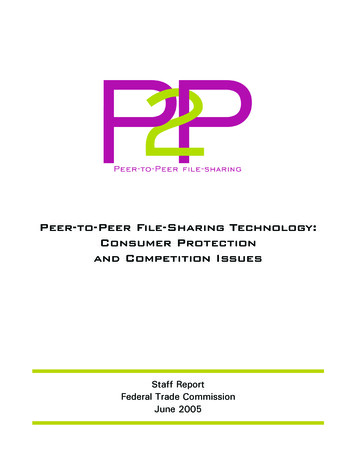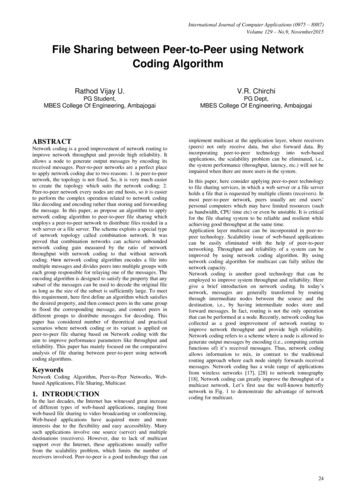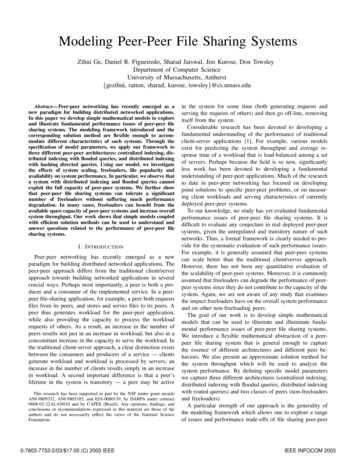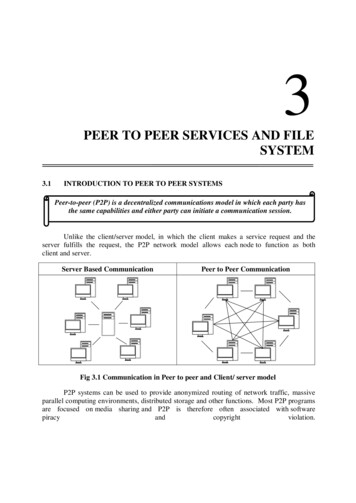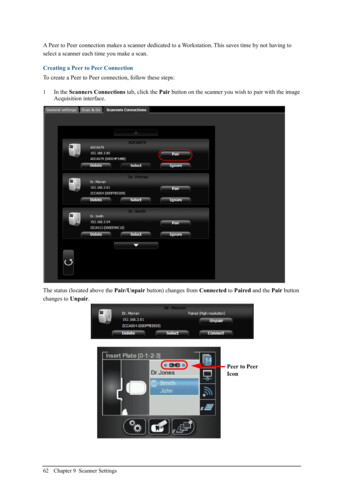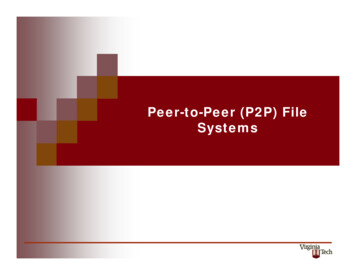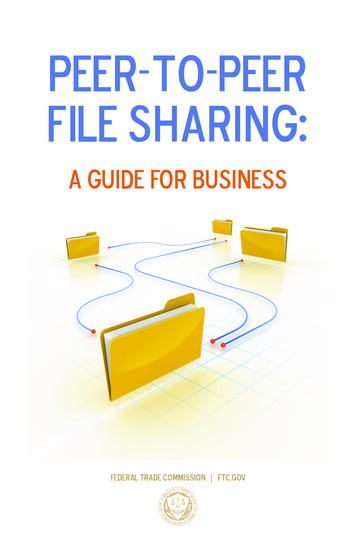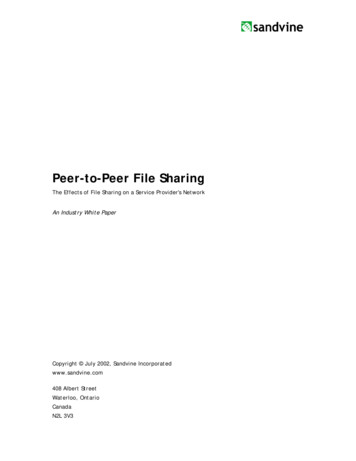
Transcription
Peer-to-Peer File SharingThe Effects of File Sharing on a Service Provider's NetworkAn Industry White PaperCopyright July 2002, Sandvine Incorporatedwww.sandvine.com408 Albert StreetWaterloo, OntarioCanadaN2L 3V3
Peer-to-Peer File SharingExecutive SummaryPeer-to-peer (P2P) file sharing has emerged as the primary siphon of Internet bandwidth.Beginning with the Napster phenomenon of the late 1990s, the popularity of P2P hasdramatically increased the volume of data transferred between Internet users. As a result,a rump percentage of the global Internet subscriber base is consuming a disproportionateshare of bandwidth – certainly more than the per-user amounts provisioned by serviceproviders.Recent studies suggest that file sharing activity accounts for up to 60% of the traffic onany given service provider network. While asymmetric bandwidth consumption is alegitimate concern on its own, the ad-hoc nature of P2P communication means that alarge amount of data traffic is pushed off-network (P2P clients don’t care where other P2Pclients are located) – driving up network access (NAP) fees.By inflating the financial pressure on service providers’ already low margins, P2P is quicklyundermining the business model for basic Internet access. In the face of surging offnetwork traffic, the traditional provider approach – managing network costs through oversubscription – is no longer sufficient.Yet the enormous popularity of file sharing and the breadth of competing protocols makesblocking P2P traffic a practical impossibility. Service providers have begun to experimentwith tiered pricing based on monthly bandwidth consumption, or capping the amount ofbandwidth available to P2P applications, but these approaches can easily be positioned aspunitive by Internet lobby groups and competitors, generating dissatisfaction amongstsubscribers and potentially aggravating customer churn.This document explores the technology and infrastructure behind peer-to-peer file sharing,and its implications for long-term service provider profitability.Copyright July 2002, Sandvine Incorporated2
Peer-to-Peer File SharingPeer-to-Peer TechnologyA Brief HistoryPeer-to-peer refers to any relationship in which multiple, autonomous devices interact asequals. A peer-to-peer network is a type of network in which workstations may act asclients (requesting data), servers (offering data) and/or servents (both a client and aserver). P2P technology enables the sharing of computer resources and services, includinginformation, files, processing cycles and storage by direct exchange between systems(without the use of central servers). P2P technology allows computers, along with theirusers, to tap idle resources that would otherwise remain unused on individual workstations.Prior to the remarkable rise and fall of Napster, systems for sharing files and informationbetween computers were exceedingly limited, and largely confined to the World WideWeb (WWW), Local Area Networks (LANs) and the exchange of files via a File TransferProtocol (FTP) connection.As the speed and pervasiveness of personal computers (PCs) increased, as well as thespeed and pervasiveness of Internet connections, so did public demand for file sharingtechnologies. Napster popularized file sharing and became, almost overnight, the singlemost popular P2P application. In February of 2001, Napster boasted a daily average of1.57 million simultaneous napster.usage, June 28 2001).P2P has since emerged as the dominant component of bandwidth used by residentialInternet subscribers. The evolution from Napster to KaZaA, Gnutella, Morpheus and othershas dramatically increased the amount of data transferred across service providernetworks. Many home PCs are now being used as P2P data servers twenty-four hours a day,seven days a week.Styles of P2PThere are three basic styles of P2P file sharing: The One-to-One relationship, typically a transfer of files from PC to PC The more advanced One-to-Many relationship used by Napster, which enables asingle host to communicate and share files with multiple nodes. Examples includemail servers connected to multiple mail clients and HTTP servers communicatingwith browsers. The Many-to-Many relationship used by Gnutella protocol clients like BearShareand Morpheus, which enables highly automated resource sharing among multiplenodesCopyright July 2002, Sandvine Incorporated3
Peer-to-Peer File SharingPeer-to-Peer FrameworksCentralized FrameworkFirst generation P2P (e.g. Napster) utilizes the server-client network structure. Thecentralized server acts as a sort of “traffic cop,” as shown in Figure 1.Figure 1: Centralized Peer-to-Peer NetworkThe central server maintains directories of shared files stored on each node. Each time aclient logs on or off the network, the directory is updated. In this model, all control andsearch messages are sent to a central server. The central server then cross-references theclient’s search request with its directory database and displays any matches to therequesting client. Once informed about a match, the client contacts the peer directly anddownloads the requested file. The actual file is never stored on the central server.The centralized P2P framework provides the highest performance when it comes tolocating files. Every individual peer in the network must be registered, which ensures thatall searches are comprehensive and execute quickly and efficiently.Decentralized FrameworkSecond generation P2P (e.g. Gnutella protocol) uses a distributed model where there is nocentral server and every node has equal status. Each node acts as a servent, or a ‘peer’,and operates as both a client and a server to the network.As is evident in Figure 2, every node within the framework tries to maintain some numberof connections (typical range is 4-8) to other nodes at all times. This set of connectednodes carries the network traffic, which is essentially made up of queries, replies to thosequeries, and various control messages that facilitate the discovery of other nodes.Copyright July 2002, Sandvine Incorporated4
Peer-to-Peer File SharingFigure 2: Decentralized Peer-to-Peer NetworkIn order to share files using the Gnutella protocol, the user requires a networked computer,(“Node X”), equipped with a Gnutella software program. Node X initiates a query byforwarding a request to another computer on the Gnutella network (“Node Y”). Node Ythen forwards the query to everyone that it is connected to.Although the span of this network is potentially infinite, it remains limited by the ‘timeto-live’ (TTL) constraint. Time-to-live refers to the layers of nodes that the requestmessage will reach. Query messages are sent with a time-to-live field (typical range is 4-6)that is decremented and then forwarded by each node to all other connected nodes. If,after decrementing the TTL field, the TTL field is found to be zero, the message will notbe forwarded along any further connections. Each node that receives the query will thenreply (included in the reply is the file name, size, etc.) and all replies are forwarded backto the origin of the query, Node X, via Node Y. Node X can now open a direct connectionwith one of the replying nodes (“Node Z”), and download the file. Files are transferreddirectly, without the intervention of intermediate nodes (the download is executed using aprotocol similar to HTTP version 1 protocol). This is the approach utilized by Gnutellaprotocol applications such as BearShare, Limewire, Gnucleus, and Morpheus.A decentralized framework does not rely on a central server, and is therefore more robustthan its centralized counterpart. Disadvantages to the decentralized model appear in theform of prolonged search times. An outgoing search request may need to travel throughthousands of users before any results are identified.Controlled Decentralized FrameworkThird generation P2P (e.g. FastTrack, KaZaA, Grokster, Groove, and current Gnutellaclients) employs a hybrid of the central-server and fully decentralized frameworks. Withinthis hybrid model, certain nodes in the network are elected ‘super-nodes’ or ‘ultrapeers’and act as traffic cops for the other nodes. The super-nodes change dynamically asbandwidth and the network topology change. A client-node keeps only a small number ofconnections open and each of those connections is to a super-node. This has an effect ofmaking the network scale, by reducing the number of nodes involved in message handlingand routing, as well as by reducing the actual volume of traffic among them. It is becauseCopyright July 2002, Sandvine Incorporated5
Peer-to-Peer File Sharingof these super-nodes, which also act as search hubs, that the speed at which queries areanswered within the controlled framework is comparable to a centralized network model.An example of this type of network is shown below in Figure 3.Figure 3: Controlled Decentralization Peer-to-Peer NetworkIn the controlled decentralization framework, each node forwards a list of its shared filesto its super-node (“Node Y”). Search requests are directed to the appropriate Node Y,which will then forward the request to other super-nodes. When a match is found, therequesting node, or Node X, connects directly to the node with the match, Node Z, anddownloads the file.Copyright July 2002, Sandvine Incorporated6
Peer-to-Peer File SharingPeer-to-Peer ApplicationsDirect Exchange of ServicesPeer-to-peer networks enable the sharing of services by direct exchange between nodes.Services include cache storage, disk storage, information, and files. It was through theefforts of Napster that this category of P2P application was first brought into publicattention.Grid ComputingGrid computing, also known as collaborative computing, is a form of P2P computing inwhich unused CPU cycles are channeled towards a common purpose. Grid computingbecame a popular topic when the SETI@Home project was launched on May 17, 1999(http://www.berkeley.edu). SETI@Home is a screen saver application that harnesses theunused CPU cycles of hundreds of thousands of volunteers’ computers to analyze theresults of the search for extra-terrestrial intelligence. Grid computing is commonly foundin science, biotech and financial environments, where there is a need for intensecomputer processing.Distributed Information InfrastructureDistributed information infrastructure is a method of P2P that brings all of the informationassets and resources of an organization together to form a “Virtual Organization.” Avirtual organization may consist of multiple companies, or multiple branches, uniting asone to strive towards a common goal. Many firms within the healthcare industry, alongwith the scientific research and development sectors, use this type of P2P application tomanage, distribute and retrieve important data and information. Distributed informationinfrastructure offers an effective, and efficient, way to span geographical andorganizational boundaries.Copyright July 2002, Sandvine Incorporated7
Peer-to-Peer File SharingPeer-to-Peer & Service ProvidersProfitability of Service ProvidersA service provider carries various costs that can be allocated to individual subscribers.One of the most significant of these costs is the service provider’s Internet transit charge.Internet transit charges are a substantial variable cost; the more a subscriber uses theservice, the more it costs the service provider. The competitive market for Internetaccess demands that customers be given unlimited access to the Internet. However,service providers purchase their bandwidth from an Inter-Exchange Carrier (IXC) based onthe total bandwidth used. This undermines the profitability of offering flat rate Internetaccess service.Direct Exchange of Services – The Contributing FactorAccording to the Cooperative Association for Internet Data Analysis (CAIDA), serviceprovider network traffic is dominated by peer-to-peer file sharing applications and WWWprotocols. Figure 4 displays a breakdown of Internet traffic over a service provider’snetwork in a given week (http://www.caida.org, Mar 13, 2002).Figure 4: Internet Traffic BreakdownCopyright July 2002, Sandvine Incorporated8
Peer-to-Peer File SharingP2P applications generate two types of network traffic: Network overhead traffic (searches, keep-alives) Data traffic (file transfers)P2P network traffic consumes a large portion of bandwidth, and as P2P application usagecontinues to increase, so do service providers’ Internet transit charges. At the height ofNapster’s popularity, Indiana University banned all P2P file swapping applications afterdiscovering that the protocol was responsible for 50 percent of their network 6/tech-oddcouple111600.html, Nov 16,2000).P2P continues to evolve through the continuous development of new file swappingapplications. Together, the FastTrack and Gnutella protocols currently boast anoutstanding 2.9 million simultaneous users (www.slyck.com, July 2, 2002). Figure 5illustrates the array of P2P applications currently available to online users.Figure 5: Common P2P ApplicationsPeer-to-Peer NetworkOn start-up, a P2P application will connect to a number of other P2P nodes which can beanywhere on the Internet. Because there is no correlation to the underlying IP networkstructure and cost model, the closest P2P peer/node is rarely located on the samenetwork. As a result, a very low percentage of P2P nodes within a service provider’snetwork will ever connect to one another. The organization of a typical P2P network isdisplayed in Figure 6.Copyright July 2002, Sandvine Incorporated9
Peer-to-Peer File SharingFigure 6: Typical P2P Network OverviewFile sharing applications are comprised of two main bandwidth consumers: The connection management of the client to the network The downloading of files, which is simply the transfer of files from one P2P host toanother, anywhere on the Internet.The connection component of P2P traffic is comprised of a number of connections todifferent P2P hosts; anywhere in the network or the Internet. Each connection uses anumber of messages intended to keep the connection alive over a period of time andinsure that file searches are quickly resolved. This component of P2P networking iscommonly referred to as ‘protocol chatter’. Figure 7 illustrates the two main forms ofP2P network traffic.Figure 7: P2P Network TrafficA popular misconception with P2P networking is that file transfers account for the vastmajority of the bandwidth consumed. In reality, a very large percentage of bandwidth isrequired for protocol chatter. In some protocols, P2P chatter generates approximately 50to 150 Kbps of traffic continuously per P2P host PC.This leaves service providers with few options to reduce their Internet transit charges.Possible solutions include switching to tiered bandwidth services, or capping the amountof bandwidth available to P2P applications. However, this is likely to cause dissatisfactionamong the subscriber base.Copyright July 2002, Sandvine Incorporated10
Peer-to-Peer File SharingConclusionGiven the current – and growing – popularity of P2P file sharing, service providers mustadopt methods to manage the impact of P2P traffic on their networks. In order toenhance profitability and reinstate a prosperous business model, service providers mustaddress both the issue of P2P file sharing and successfully manage the protocol chatterthat consumes such a large percentage of network bandwidth.Copyright July 2002, Sandvine Incorporated11
Peer-to-Peer File SharingAppendixGlossary Client: a node that requests a service of a server, using some kind of networkprotocol and accepts the server’s responses. Server: a node that provides a service for other clients that are connected to it viaa network. Servent: a device that acts as both a client and a server simultaneously. Client-Server: A two-node relationship characterized by fixed capabilities wherethe client and server are confined to rigidly defined roles. Node/Peer: a device that is capable of both initiating communications andaccepting communications initiated elsewhere. Peer-to-Peer: any relationship in which multiple, autonomous devices interact asequals. Time-to-Live (TTL): refers to the number of layers of peers that a request messagewill reach, therefore limiting the span of a peer-to-peer network. Network Topology: the pattern of interconnection between nodes in a network. Protocol Chatter: a number of messages that are intended to keep a networkconnection alive over a period of time, such as queries, query hits, pings andpongs. Bandwidth: the transmission capacity of an electronic line such as acommunications network, computer bus or computer channel. It is expressed inbits per second, bytes per second or in Hertz (cycles per second). Message: the entity in which information is transmitted over the network.Sometimes the word "packet" or “descriptor” is used with the same meaning.References Slyck, www.slyck.com RFC Gnutella, rfc-gnutella.sourceforge.net CAIDA, www.caida.org Peer-to-Peer Central, www.peertopeercentral.com OpenP2P, www.openp2p.comCopyright July 2002, Sandvine Incorporated12
Peer-to-peer (P2P) file sharing has emerged as the primary siphon of Internet bandwidth. Beginning with the Napster phenomenon of the late 1990s, the popularity of P2P has dramatically increased the volume of data transferred between Internet users.
